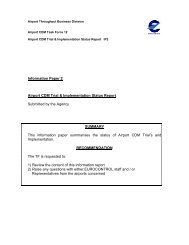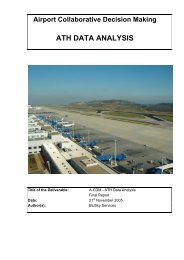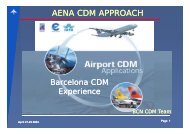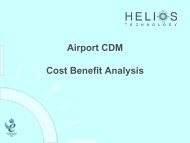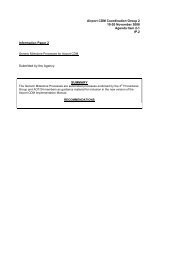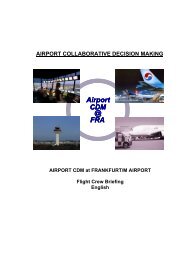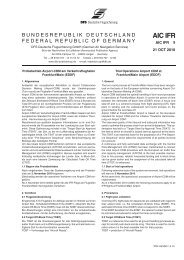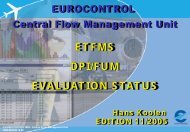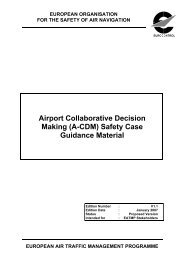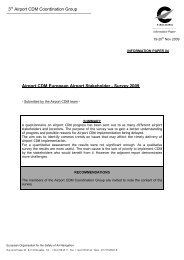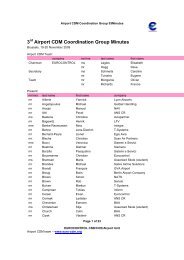Brief Description (pdf) - Airport Collaborative Decision Making
Brief Description (pdf) - Airport Collaborative Decision Making
Brief Description (pdf) - Airport Collaborative Decision Making
Create successful ePaper yourself
Turn your PDF publications into a flip-book with our unique Google optimized e-Paper software.
<strong>Airport</strong> CDM München<br />
AIRPORT<br />
COLLABORATIVE<br />
DECISION<br />
MAKING<br />
- AIRPORT CDM MUNICH -<br />
BRIEF DESCRIPTION<br />
- PROCESS DESCRIPTION -<br />
Version 5
Version: V 5.0<br />
Author: <strong>Airport</strong> CDM Team München<br />
Date: 5 th JULY 2009<br />
Number of pages: 39<br />
<strong>Airport</strong> CDM München<br />
<strong>Airport</strong> CDM MUC – <strong>Brief</strong> <strong>Description</strong> Page 2
Contents:<br />
<strong>Airport</strong> CDM München<br />
1. General ...................................................................................................................... 5<br />
1.1. Purpose of the document .................................................................................. 5<br />
1.2. General, definition and partners ........................................................................ 5<br />
1.3. Objectives of <strong>Airport</strong> CDM ................................................................................. 6<br />
1.4. Coordination with the CFMU ............................................................................. 6<br />
1.5. Main characteristics of the procedure................................................................ 7<br />
2. Procedure .................................................................................................................. 8<br />
2.1. Overview on the procedure ............................................................................... 8<br />
2.2. Combination of different flight information ......................................................... 9<br />
2.2.1. <strong>Airport</strong> slot discrepancy ............................................................................. 9<br />
2.2.2. <strong>Airport</strong> slot missing .................................................................................... 9<br />
2.2.3. Points of contact ........................................................................................ 9<br />
2.2.4. Early DPI — data exchange with the CFMU............................................ 10<br />
2.2.5. Target DPI — data exchange with the CFMU ......................................... 11<br />
2.2.6. Flight update message (FUM) — data exchange with the CFMU ........... 12<br />
2.2.7. Potential <strong>Airport</strong> CDM alerts .................................................................... 12<br />
2.3. Target off-block time (TOBT)........................................................................... 13<br />
2.3.1. Automatically generated TOBT................................................................ 13<br />
2.3.2. Person in charge of the TOBT ................................................................. 14<br />
2.3.3. TOBT inputs and adjustments ................................................................. 14<br />
2.3.4. Deviations of the TOBT from the EOBT .................................................. 14<br />
2.3.5. TOBT deletion.......................................................................................... 15<br />
2.3.6. Cancel DPI — data exchange with the CFMU......................................... 15<br />
2.3.7. TOBT in the case of a change of aircraft ................................................. 15<br />
2.3.8. TOBT reporting channels......................................................................... 16<br />
2.3.9. TOBT indication at positions with electronic display................................ 18<br />
2.3.10. Potential <strong>Airport</strong> CDM alerts .................................................................... 18<br />
2.4. Target start-up approval time – TSAT ............................................................. 19<br />
2.4.1. Calculation of the TSAT........................................................................... 19<br />
2.4.2. TSAT reporting channels......................................................................... 20<br />
2.4.3. TSAT changes......................................................................................... 20<br />
2.4.4. Target DPI "Sequenced" - data exchange with the CFMU ...................... 21<br />
2.4.5. Examples of the TSAT and DPI generation............................................. 22<br />
2.4.6. Changes within the sequence.................................................................. 23<br />
<strong>Airport</strong> CDM MUC – <strong>Brief</strong> <strong>Description</strong> Page 3
<strong>Airport</strong> CDM München<br />
2.4.7. TOBT and TSAT handling in extreme situations ..................................... 23<br />
2.4.8. Potential <strong>Airport</strong> CDM alerts .................................................................... 23<br />
2.5. Aircraft de-icing................................................................................................ 24<br />
2.6. Start-up and push-back ................................................................................... 25<br />
2.6.1. Datalink clearance - DCL......................................................................... 26<br />
2.6.2. Remote holding........................................................................................ 26<br />
2.6.3. ATC DPI – data exchange with the CFMU .............................................. 27<br />
3. Common situational awareness/information sharing ............................................... 28<br />
3.1. SEPL dialogue................................................................................................. 28<br />
3.2. WEASEL dialogue ........................................................................................... 29<br />
3.3. UDS page ........................................................................................................ 31<br />
3.4. Display system of the CFMU – CFMU CHMI .................................................. 32<br />
3.4.1. CFMU CHMI flight list .............................................................................. 32<br />
3.4.2. CFMU CHMI flight data............................................................................ 33<br />
3.4.3. CFMU CHMI flight data............................................................................ 34<br />
3.5. <strong>Airport</strong> CDM alerting/information messages.................................................... 35<br />
3.5.1. Contact address and information............................................................. 35<br />
3.5.2. General aviation flights ............................................................................ 35<br />
3.5.3. <strong>Airport</strong> CDM information messages......................................................... 35<br />
3.5.4. CDM01: No airport slot available, or slot already correlated ................... 35<br />
3.5.5. CDM02: SOBT vs EOBT discrepancy ..................................................... 36<br />
3.5.6. CDM03: Aircraft type discrepancy ........................................................... 36<br />
3.5.7. CDM04: Registration discrepancy ........................................................... 36<br />
3.5.8. CDM05: Destination discrepancy ............................................................ 36<br />
3.5.9. CDM07: EIBT + MTTT discrepancy with EOBT ...................................... 37<br />
3.5.10. CDM07b: EIBT + MTTT discrepancy with TOBT..................................... 37<br />
3.5.11. CDM08: EOBT compliance alert.............................................................. 37<br />
3.5.12. CDM09: Boarding not started .................................................................. 37<br />
3.5.13. CDM10: TOBT rejected or deleted .......................................................... 37<br />
3.5.14. CDM13: No ATC flight plan available ...................................................... 38<br />
3.5.15. CDM14: Automatic TOBT generation not possible.................................. 38<br />
4. Publications.............................................................................................................. 39<br />
4.1. Aeronautical information publication (AIP) ...................................................... 39<br />
4.2. <strong>Airport</strong> user regulations ................................................................................... 39<br />
5. Persons in charge of the process/points of contact ................................................. 39<br />
<strong>Airport</strong> CDM MUC – <strong>Brief</strong> <strong>Description</strong> Page 4
1. General<br />
<strong>Airport</strong> CDM München<br />
1.1. Purpose of the document<br />
This document describes the <strong>Airport</strong> <strong>Collaborative</strong> <strong>Decision</strong> <strong>Making</strong> (CDM) procedure in<br />
Munich and is to be understood and used as a basis for the different partners, such as<br />
ground handling agents and Airline OCC.<br />
Together with the publications about <strong>Airport</strong> CDM (Aeronautical Information Publication –<br />
AIP – Germany, <strong>Airport</strong> Regulatary Book – FBO – Munich), this document is to ensure<br />
that <strong>Airport</strong> CDM in Munich is handled optimally in the interest of all partners.<br />
1.2. General, definition and partners<br />
<strong>Airport</strong> CDM is an operational approach for the optimum handling of the turn-round<br />
process at the airport. It covers the period of time between the estimated off-block time<br />
(EOBT) -3hrs and take-off and is a coherent process from flight planning (ATC flight<br />
plan) to landing and the subsequent turn-round process on the ground before the next<br />
take-off.<br />
European <strong>Airport</strong> CDM<br />
„Definition and Partners“<br />
<strong>Airport</strong> CDM is an operational overall process (concept/procedure<br />
concept/procedure) ) supporting<br />
an optimized turnround process at an airport. airport.<br />
It is basis for connection to the<br />
European ATM network<br />
<strong>Airport</strong> CDM in Munich was developed by FMG and DFS. It is based on<br />
European <strong>Airport</strong> CDM<br />
<strong>Airport</strong> CDM partners are: are<br />
ATC Tower All Airlines and<br />
Ground handlers<br />
<strong>Airport</strong><br />
Apron Control<br />
<strong>Airport</strong> Traffic Ops<br />
Centre<br />
European Air<br />
Traffic flow<br />
management<br />
(CFMU)<br />
• <strong>Airport</strong> (CDM) - one operational process<br />
= ATC Flight plan / Arrival / Ground handling / Take Off<br />
• <strong>Airport</strong> CDM procedure comprises the time period EOBT-3hr EOBT hr till Take Off<br />
The one-year trial operations were integrated into regular operations on 7 June 2007,<br />
making Munich the first airport in Europe to implement <strong>Airport</strong> CDM as a standard<br />
procedure. <strong>Airport</strong> CDM at Munich <strong>Airport</strong> is based on the European <strong>Airport</strong> CDM and<br />
the knowledge gained from the preceding COB procedure in Munich.<br />
The Munich airport operator FMG and DFS are contributing the practical experience and<br />
findings of operational services to the developments taking place at a European level.<br />
<strong>Airport</strong> CDM MUC – <strong>Brief</strong> <strong>Description</strong> Page 5
<strong>Airport</strong> CDM München<br />
1.3. Objectives of <strong>Airport</strong> CDM<br />
<strong>Airport</strong> CDM aims at optimally utilising the available capacities and operational resources<br />
at the airport by increasing the efficiency of the individual steps of the turn-round<br />
process.<br />
<strong>Airport</strong>s can be integrated into the European ATM network through the exchange of<br />
reliable estimated arrival and departure times between <strong>Airport</strong> CDM and the Central Flow<br />
Management Unit (CFMU).<br />
<strong>Airport</strong> CDM optimises operational cooperation between the following partners:<br />
• <strong>Airport</strong> operator<br />
• Airlines<br />
• Handling agents<br />
• Ground handling agents<br />
• Air navigation service provider<br />
• European air traffic flow management (CFMU)<br />
1.4. Coordination with the CFMU<br />
Due to a fully automated data exchange with the Central Flow Management Unit<br />
(CFMU), landing and take-off times can be forecast in a timely and reliable manner<br />
and/or precisely calculated take-off times (CTOT) can be given, based on local target<br />
take-off times.<br />
The following messages are used:<br />
• Flight update message, FUM<br />
• Early departure planning information message, E-DPI<br />
• Target departure planning information message, T-DPI<br />
• ATC departure planning information message, A-DPI<br />
The basic procedures for cooperation between the airlines and/or DFS and the CFMU<br />
remain the same.<br />
Furthermore, all estimated departure times are automatically transmitted to the CFMU<br />
during the turn-round process. In the case of delays caused by the airlines, the common<br />
CTOT allocation mechanisms apply. These allocation mechanisms are confirmed and/or<br />
refined via DPI messages. The CFMU determines and allocates the CTOT on the basis<br />
of these estimated departure times (DPI).<br />
<strong>Airport</strong> CDM MUC – <strong>Brief</strong> <strong>Description</strong> Page 6
<strong>Airport</strong> CDM München<br />
1.5. Main characteristics of the procedure<br />
The main characteristics of <strong>Airport</strong> CDM are:<br />
• Transparency of the process<br />
Common situational awareness is guaranteed for all partners<br />
• <strong>Airport</strong> CDM is a common operational process<br />
ATC flight plan/landing/turn-round process/take-off<br />
• Combination of the day of operations and schedule planning<br />
Comparison and adjustment of the ATC flight plan, airport slot and airport flight<br />
data<br />
• Feasibility of the turn-round process<br />
Combination, check and adjustment of linked arrivals and departures<br />
• Use of the target off-block time as the target time for "Aircraft ready"<br />
TOBT = Airline commitment<br />
• Use of variable taxi times – VTT (EXOT=Remaining Time – RMT –)<br />
Calculation of all target times, taking account of the position, runway-in-use and<br />
current landing direction<br />
• Introduction of the target start-up approval time<br />
The TSAT, resulting from the TOBT, EXOT, CTOT (if regulated) and the actual<br />
operational capacity, provides the basis for the pre-departure sequence and the<br />
latest point of time at which the start-up approval can be expected.<br />
TSAT = <strong>Airport</strong> CDM commitment<br />
• Procedure adherence<br />
Start-up approvals/push-back clearances are issued taking the TOBT and TSAT<br />
into account.<br />
• "Linking the airport into the network"<br />
High-quality forecasts for inbound and outbound air traffic by means of an<br />
automated data exchange with European ATFM (CFMU)<br />
<strong>Airport</strong> CDM MUC – <strong>Brief</strong> <strong>Description</strong> Page 7
2. Procedure<br />
<strong>Airport</strong> CDM München<br />
2.1. Overview on the procedure<br />
This chart depicts the scope of the <strong>Airport</strong> CDM procedure at Munich <strong>Airport</strong> from the<br />
time of ATC flight plan activation (EOBT -3h) to take-off. The orange arrows depict the<br />
data transfer with the CFMU, the brown arrow shows the exchange of information via<br />
interfaces, dialogue systems, e-mail etc. with the relevant aircraft operator and/or<br />
handling agent with regard to potential adjustments which may become necessary.<br />
<strong>Airport</strong> CDM Munich<br />
08 00<br />
08 30<br />
Take Off<br />
Outstation<br />
„Procedure Procedure - Overview“ Overview<br />
1200 1030 0900 1000 0930 1100 1130 1230 ATC-<br />
FPL<br />
(EOBT-3h)<br />
F<br />
U<br />
M<br />
Early-DPI<br />
(FPL/Schedule-Comparison)<br />
Estimated Landing time<br />
(CFMU/DFS)<br />
EOBT-2h<br />
(CTOT)<br />
Final<br />
approach<br />
„TMO“<br />
<strong>Airport</strong> CDM MUC – <strong>Brief</strong> <strong>Description</strong> Page 8<br />
Landing<br />
TSAT<br />
Issue<br />
(TOBT-40min)<br />
Inblock<br />
Start<br />
Ground<br />
handling<br />
Ground<br />
handling<br />
Automatic calculation TOBT<br />
Target-DPI (ATTOT)<br />
(„Slot Adjustment Window“)<br />
Information exchange (Dialog; Interfaces; Alerts; E-mail mail)<br />
(i.e i.e. . EOBT/SOBT-Mismatch<br />
EOBT/SOBT Mismatch; ; Acft-Type Acft Type; ; Acft-Registration<br />
Acft Registration)<br />
TSAT<br />
Aircraft<br />
ready<br />
Start Up<br />
ASAT<br />
TOBT<br />
AOBT<br />
ATC-DPI<br />
(CTOT Freeze)<br />
The main aspects of the procedure are sub-divided and described as follows:<br />
• Combination of different flight information – section 2.2<br />
• Target off-block time – section 2.3<br />
• Target start-up approval time – section 2.4<br />
• Aircraft de-icing – section 2.5<br />
• Start-up and push-back – section 2.6<br />
„Take<br />
Off“<br />
ATOT
<strong>Airport</strong> CDM München<br />
2.2. Combination of different flight information<br />
The <strong>Airport</strong> CDM procedure begins with the transmission of the ATC flight<br />
plan to the <strong>Airport</strong> CDM Portal (airport operator data base).<br />
The ATC flight plans, the flight data submitted to the airport as well as the<br />
airport slots (SOBT) included therein are combined, correlated and<br />
compared. In particular, the focus is on:<br />
• combining inbound and outbound flights<br />
• comparing the airport slot (SOBT) for the outbound flight<br />
This comparison is usually made at the EOBT -3hrs. If the ATC flight plan is<br />
filed at a later stage, the commencement of the <strong>Airport</strong> CDM procedure is<br />
postponed to this time.<br />
2.2.1. <strong>Airport</strong> slot discrepancy<br />
If no airport slot is available or if the SOBT deviates from the estimated offblock<br />
time (EOBT), the contact person of the airline is advised to adjust the<br />
times accordingly.<br />
2.2.2. <strong>Airport</strong> slot missing<br />
If no airport slot is available at the time of the expected conduct of the flight,<br />
the flight cannot be sequenced and thus not handled or conducted.<br />
2.2.3. Points of contact<br />
The FMG traffic operation centre is in charge of the activities concerning the<br />
combination of different flight information.<br />
Combination of different flight Information<br />
ATC – Flightplan / <strong>Airport</strong> flight data information / <strong>Airport</strong> Slot<br />
<strong>Airport</strong> CDM MUC – <strong>Brief</strong> <strong>Description</strong> Page 9
<strong>Airport</strong> CDM München<br />
2.2.4. Early DPI — data exchange with the CFMU<br />
An early departure planning information message (E-DPI) is generated and<br />
transmitted to the CFMU for flight plans validated in accordance with the<br />
sections mentioned above (airport slot available).<br />
Flights with an E-DPI are marked in the CFMU system as flights from a CDM<br />
airport and are then considered accordingly in further processing (e.g. optimised<br />
CTOT allocation in accordance with the local target times).<br />
Example of the early DPI<br />
- TITLE DPI<br />
- DPISTATUS EARLY<br />
- ARCID DLH3354<br />
- ADEP EDDM<br />
- ADES LTBA<br />
- EOBT 1825<br />
- EOBD 090105<br />
- TTOT 1844<br />
- SOBT 1825<br />
- SID CHIEM4S<br />
- TAXITIME 0019<br />
- ARCTYP A320<br />
- REG DAIPU<br />
- ORGN EDDMYDYE<br />
Combination of different flight Information<br />
1. Early DPI towards CFMU<br />
<strong>Airport</strong> CDM MUC – <strong>Brief</strong> <strong>Description</strong> Page 10
<strong>Airport</strong> CDM München<br />
2.2.5. Target DPI — data exchange with the CFMU<br />
As a rule, a T-DPI with the status "Target" is generated two hours before the<br />
EOBT for all flights for which an E-DPI has been generated. The T-DPI is<br />
transmitted to the CFMU in the same way as the E-DPI.<br />
The T-DPI is used to transmit a target take-off time (TTOT) to the CFMU.<br />
The T-DPI opens a so-called slot adjustment window within which the CTOT<br />
is adjusted to the relevant reported TTOT in the best possible manner.<br />
If the TTOT is changed by five minutes or more, if taxi times are adjusted by<br />
three minutes or more or if the SID, aircraft type or registration is changed, a<br />
new T-DPI is generated and transmitted to the CFMU.<br />
Example of the target DPI:<br />
- TITLE DPI<br />
- DPISTATUS TARGET<br />
- ARCID DLH3354<br />
- ADEP EDDM<br />
- ADES LTBA<br />
- EOBT 1825<br />
- EOBD 090105<br />
- TTOT 1844<br />
- SID CHIEM4S<br />
- TAXITIME 0019<br />
- ARCTYP A320<br />
- REG DAIPU<br />
- ORGN EDDMYDYE<br />
Combination of different flight Information<br />
1. Target DPI towards CFMU<br />
<strong>Airport</strong> CDM MUC – <strong>Brief</strong> <strong>Description</strong> Page 11
<strong>Airport</strong> CDM München<br />
2.2.6. Flight update message (FUM) — data exchange with the CFMU<br />
Flight update messages (FUM) are received for flights to Munich <strong>Airport</strong><br />
(inbound). The following operational events trigger the transmission of an<br />
FUM:<br />
• Estimated landing time (ELDT) minus 3 hours<br />
• Modification of the ELDT by 5 minutes or more (parameter 5 - 15<br />
minutes)<br />
• Changes to the ETFMS status, e.g. suspension of a flight.<br />
The FUM provides an ELDT in advance which allows the system to compare<br />
the inbound with the outbound flight plan, i.e. the EIBT with the EOBT.<br />
If the calculated EIBT is later than the EOBT of the linked outbound flight<br />
plan, the contact person of the airline is notified accordingly. It is expected<br />
that the relevant times (delay message - DLA -) or the outbound flight plan<br />
(change of aircraft – CHG – or flight plan cancellation – CNL – and new flight<br />
plan) will be adjusted in a timely manner.<br />
Furthermore, the ELDT of the FUM has strong effects on:<br />
• optimum gate and position planning as well as further resources<br />
planning<br />
• automatic TOBT generation<br />
• further use of resources (e.g. ground handling)<br />
2.2.7. Potential <strong>Airport</strong> CDM alerts<br />
Potential <strong>Airport</strong> CDM alerts (information messages) concerning the<br />
combination of different flight information described in section 0 include:<br />
CDM 01 No airport slot available, or slot already correlated<br />
CDM 02 SOBT vs EOBT discrepancy<br />
CDM 03 Aircraft type discrepancy<br />
CDM 04 Registration discrepancy<br />
CDM 05 Destination discrepancy<br />
CDM 07 EIBT + MTTT discrepancy with EOBT<br />
CDM 08 EOBT compliance alert<br />
CDM 13 No ATC flight plan available<br />
Details on the <strong>Airport</strong> CDM alerts are given in section 3.5.<br />
Combination of different flight Information<br />
Inboundinformation and Alerting<br />
<strong>Airport</strong> CDM MUC – <strong>Brief</strong> <strong>Description</strong> Page 12
<strong>Airport</strong> CDM München<br />
2.3. Target off-block time (TOBT)<br />
The TOBT is a point of time monitored and to be confirmed by the<br />
airline/handling agent at which the ground handling process is concluded, all<br />
aircraft doors are closed, all passenger boarding bridges have been removed<br />
from the aircraft and thus start-up approval and push-back/taxi clearance can<br />
be received.<br />
All ground handling processes, except for push-back and remote de-icing,<br />
are based on the TOBT. The TOBT is used as the optimum time for<br />
coordination.<br />
• TOBT = Forecast of "Aircraft ready"<br />
2.3.1. Automatically generated TOBT<br />
During the final approach phase, the sequence planner system automatically<br />
generates a TOBT for the linked outbound flight.<br />
The earliest time for the generation of a TOBT is the TOBT -75 minutes.<br />
The minimum turn-round time (MTTT) is applied when the TOBT is<br />
generated. The MTTT is a time which is stored in the system and depends<br />
on the airline, aircraft type and destination airport.<br />
Important dependencies for the automatic initial TOBT generation:<br />
• TOBT = EOBT if: EIBT + MTTT ≤ EOBT<br />
• TOBT = EIBT + MTTT if: EIBT + MTTT > EOBT<br />
• TOBT for flights with a CTOT only: if: TOBT + EXOT ≤ CTOT<br />
If the TOBT is not automatically generated for a flight, it has to be entered by<br />
the person in charge of the TOBT as described in section 2.3.3.<br />
For aircraft which are not subject to a direct turn-round and which do not park<br />
on their outgoing position, the TOBT is generated at the time of off-block<br />
from the preceding position.<br />
Target Off Block Time - TOBT<br />
Definition and automatic genaration<br />
<strong>Airport</strong> CDM MUC – <strong>Brief</strong> <strong>Description</strong> Page 13
2.3.2. Person in charge of the TOBT<br />
Airlines are to ensure<br />
<strong>Airport</strong> CDM München<br />
• the definition of responsibility for the TOBT,<br />
• communication with the relevant airline OCC (ATC flight plan/person<br />
in charge of the EOBT) and<br />
• coordination of internal working procedures.<br />
The person in charge of the TOBT (generally the handling agent), the airline<br />
(for flights without handling agent) or the pilot-in-command (for general<br />
aviation flights without handling agent) is responsible for the correctness of<br />
and adherence to the TOBT.<br />
A wrong TOBT leads to disadvantages for further sequencing and/or CTOT<br />
allocation of regulated flights. Therefore, the TOBT has to be adjusted as<br />
soon as possible.<br />
2.3.3. TOBT inputs and adjustments<br />
The following has to be taken into account for the input and/or adjustment of<br />
the TOBT:<br />
• The TOBT can be adjusted as often as necessary until the TSAT has<br />
been issued.<br />
• After the TSAT has been issued, the TOBT can only be corrected<br />
three times.<br />
• The entered TOBT has to be at least 5 minutes later than the current<br />
point of time.<br />
As the TOBT is also the basis for further airport processes, adjustments of<br />
the TOBT (also if the process is completed more than five minutes in<br />
advance) are to be entered by the person in charge of the TOBT.<br />
2.3.4. Deviations of the TOBT from the EOBT<br />
If the TOBT deviates from the EOBT of the ATC flight plan by more than 15<br />
minutes, the airline has to initiate another delay message (DLA, CHG). This<br />
time (EOBT) has to be based on the last TOBT.<br />
Target Off Block Time - TOBT<br />
Person in Charge / Inputs and adjustments / Deviations<br />
<strong>Airport</strong> CDM MUC – <strong>Brief</strong> <strong>Description</strong> Page 14
<strong>Airport</strong> CDM München<br />
2.3.5. TOBT deletion<br />
The TOBT has to be deleted in the following cases:<br />
• The TOBT is unknown (e.g. technical problems with the aircraft).<br />
• The permitted number of TOBT inputs (3x) after the generation of<br />
the TSAT has been exceeded.<br />
If the TOBT is deleted, the TSAT is automatically deleted as well.<br />
If a new TOBT is known and if this process interruption is to be<br />
discontinued, the person in charge of the TOBT has to enter a new TOBT.<br />
2.3.6. Cancel DPI — data exchange with the CFMU<br />
As soon as the TOBT for a flight is deleted, a C-DPI message is transmitted<br />
to the CFMU. The flight is not subject to the special handling process (for<br />
flights from CDM airports). The CTOT is then issued on the basis of the<br />
flight plan data available at the CFMU until a new DPI (triggered by the new<br />
TOBT input) is available for the flight.<br />
- TITLE DPI<br />
- DPISTATUS CNL<br />
- ARCID DLH3354<br />
- ADES LTBA<br />
- ADEP EDDM<br />
- EOBT 1825<br />
- EOBD 090105<br />
- REASON TOTUNKOWN<br />
- ORGN EDDMYDYE<br />
2.3.7. TOBT in the case of a change of aircraft<br />
If the aircraft is changed, a change message (CHG - type/registration) has<br />
to be issued and the TOBT remains in effect and is allocated to the new<br />
aircraft.<br />
Target Off Block Time - TOBT<br />
Deletion / Cancel DPI / Change of aircraft<br />
<strong>Airport</strong> CDM MUC – <strong>Brief</strong> <strong>Description</strong> Page 15
<strong>Airport</strong> CDM München<br />
2.3.8. TOBT reporting channels<br />
The TOBT is reported and/or adjusted in one of the following ways:<br />
• SEPL dialogue<br />
• internal system of the airline/handling agent (via interface)<br />
• by telephone via the FMG traffic operation centre (+49 (0)89 – 975 -<br />
21135)<br />
• WEASEL dialogue<br />
Chart of the TOBT reporting channels<br />
<strong>Airport</strong> CDM München<br />
Airline Operator / Handling Agent / TWR FMG<br />
SEPL-Dialog<br />
SEPL Dialog<br />
Interface<br />
AO / GH / ATC<br />
WEASEL- WEASEL Dialog<br />
local / remote<br />
By telephone<br />
www<br />
a<br />
b<br />
c<br />
d<br />
Basis System Verkehr<br />
System<br />
SEPL<br />
„Communication<br />
Communication Channels“ Channels<br />
Traffic operation<br />
center<br />
<strong>Airport</strong> CDM MUC – <strong>Brief</strong> <strong>Description</strong> Page 16<br />
e<br />
Target Off Block Time - TOBT<br />
Reporting channels
For general aviation flights:<br />
<strong>Airport</strong> CDM München<br />
• at the counter of the general aviation terminal, [+49-(0)89-975-21498;<br />
opening hours MON - SUN from 0340 until 2020], either in person or<br />
by telephone, outside the opening hours of the counter by telephone<br />
at the FMG traffic operation centre (+49-(0)89-975-21135).<br />
<strong>Airport</strong> CDM München<br />
Luftfahrzeugführer /<br />
Handling Agent<br />
Counter<br />
Telefonisch<br />
Telefonisch<br />
„General Aviation – Communication Channels“ Channels<br />
a<br />
a<br />
General Aviation<br />
Traffic operation<br />
center<br />
<strong>Airport</strong> CDM MUC – <strong>Brief</strong> <strong>Description</strong> Page 17<br />
FMG<br />
a<br />
b b<br />
Basis System Verkehr<br />
System<br />
SEPL<br />
Target Off Block Time - TOBT<br />
Reporting channels
<strong>Airport</strong> CDM München<br />
2.3.9. TOBT indication at positions with electronic display<br />
The TOBT is indicated in local time at positions with electronic display. The<br />
minutes remaining until the TOBT are also indicated as additional<br />
information. If the TOBT is exceeded, DELAY is indicated.<br />
2.3.10. Potential <strong>Airport</strong> CDM alerts<br />
Potential <strong>Airport</strong> CDM alerts concerning the TOBT include:<br />
CDM 08 EOBT compliance alert<br />
CDM 00 Boarding not started<br />
CDM 10 TOBT rejected or deleted<br />
CDM 14 Automatic TOBT generation not possible<br />
Details on the <strong>Airport</strong> CDM alerts are given in section 3.5.<br />
Target Off Block Time - TOBT<br />
Display parking position and alerting<br />
<strong>Airport</strong> CDM MUC – <strong>Brief</strong> <strong>Description</strong> Page 18
<strong>Airport</strong> CDM München<br />
2.4. Target start-up approval time – TSAT<br />
The TSAT is the latest point of time calculated by the <strong>Airport</strong> CDM sequence<br />
planner at which the start-up approval and en-route clearance can be<br />
expected.<br />
The pre-departure sequence is based on the flights with a calculated TSAT.<br />
2.4.1. Calculation of the TSAT<br />
The TSAT is calculated 40 minutes prior to the valid TOBT.<br />
After the TSAT has been calculated, the TOBT can only be corrected another<br />
three times. As a rule, the TSAT remains in effect if the TOBT is changed,<br />
unless the new TOBT is later than the calculated TSAT.<br />
The calculation of the TSAT is based on the following factors:<br />
• TOBT<br />
• CTOT in the case of regulated flights<br />
• Operational capacity<br />
• Special departure intervals (MDI)<br />
• Variable taxi time<br />
• Parking position/area<br />
• Take-off runway<br />
• Landing direction<br />
• Aircraft de-icing<br />
Target Start Up Approval Time – TSAT<br />
Definition and calculation<br />
<strong>Airport</strong> CDM MUC – <strong>Brief</strong> <strong>Description</strong> Page 19
<strong>Airport</strong> CDM München<br />
2.4.2. TSAT reporting channels<br />
The TSAT is acknowledged via the same reporting channels as the TOBT:<br />
• SEPL dialogue<br />
• internal system of the airline operator/handling agent<br />
• FMG information system (universal display station (UDS))<br />
• by telephone via the FMG traffic operation centre<br />
• WEASEL dialogue<br />
For general aviation flights:<br />
At the counter of the general aviation terminal, either in person or by<br />
telephone, outside the opening hours of the counter by telephone at the FMG<br />
traffic operation centre.<br />
2.4.3. TSAT changes<br />
If the TSAT is changed, the pilot will be informed thereof by the handling<br />
agent or by the airline via other internal reporting channels (e.g. datalink).<br />
In the case of general aviation flights, this task may be performed by DFS<br />
Clearance Delivery.<br />
Target Start Up Approval Time – TSAT<br />
Reporting channels and changes<br />
<strong>Airport</strong> CDM MUC – <strong>Brief</strong> <strong>Description</strong> Page 20
<strong>Airport</strong> CDM München<br />
2.4.4. Target DPI "Sequenced" - data exchange with the CFMU<br />
When the TSAT is generated, a T-DPI message with the status "sequenced"<br />
is transmitted to the CFMU for unregulated flights (flights without a CTOT).<br />
Flights for which a T-DPI message with the status "sequenced" has been<br />
transmitted have a particular status within the CFMU system.<br />
The status "Target" (cf. section 0) remains in effect for regulated flights.<br />
However, a T-DPI "Sequenced" can be manually generated by the control<br />
tower later on (e.g. in the case of local capacity constraints), otherwise the T-<br />
DPI for regulated flights is issued at the actual start-up time (ASAT).<br />
The transmission of a "Ready" message is no longer required for regulated<br />
flights with the T-DPI "Sequenced". The CTOT is adjusted to the local TTOT<br />
in the best possible manner.<br />
If the TTOT is changed by five minutes or more, if taxi times are adjusted by<br />
three minutes or more or if the SID, aircraft type or registration is changed, a<br />
new T-DPI is generated and transmitted to the CFMU.<br />
Examples of the target DPI:<br />
- TITLE DPI<br />
- DPISTATUS SEQ<br />
- ARCID DLH3354<br />
- ADES LTBA<br />
- ADEP EDDM<br />
- EOBT 1825<br />
- EOBD 090105<br />
- TTOT 1844<br />
- SID CHIEM4S<br />
- TAXITIME 0019<br />
- ARCTYP A320<br />
- REG DAIPU<br />
- ORGN EDDMYDYE<br />
Target Start Up Approval Time – TSAT<br />
Target DPI „Sequenced“ towards CFMU<br />
<strong>Airport</strong> CDM MUC – <strong>Brief</strong> <strong>Description</strong> Page 21
<strong>Airport</strong> CDM München<br />
2.4.5. Examples of the TSAT and DPI generation<br />
Chart 1: Unregulated flight (no CTOT) – full local capacity<br />
Pre Departure Sequence<br />
DLH 1KM<br />
TOBT: 12:00<br />
TSAT: 12:00<br />
DLH 2ES<br />
TOBT: 12:02<br />
TSAT: 12:02<br />
DLH 3KW<br />
TOBT: 12:00<br />
TSAT: 12:00<br />
EXOT<br />
15 Min.<br />
EXOT<br />
17 Min.<br />
EXOT<br />
21 Min.<br />
TSAT Issue = TOBT-40min<br />
TTOT<br />
12:01<br />
12:03<br />
12:05<br />
12:07<br />
12:09<br />
12:11<br />
12:13<br />
12:15 12:15<br />
12:17<br />
12:19<br />
12:21 12:21<br />
Capacity<br />
value<br />
60/60<br />
DLH4SH<br />
DLH5SF<br />
DLH6HF<br />
DLH1KM<br />
DLH7RW<br />
DLH2ES<br />
DLH3KW<br />
<strong>Airport</strong> CDM MUC – <strong>Brief</strong> <strong>Description</strong> Page 22<br />
TTOT<br />
12:00<br />
12:02<br />
12:04<br />
12:06<br />
12:08<br />
12:10<br />
12:12<br />
12:14<br />
12:16<br />
12:18<br />
12:20<br />
12:22<br />
CFMU<br />
CFMU<br />
CFMU<br />
DPI<br />
T-DPI-s<br />
TTOT 12:15<br />
T-DPI-s<br />
TTOT 12:19<br />
T-DPI-s<br />
TTOT 12:21<br />
Chart 2: Unregulated flight (no CTOT) – local capacity constraints<br />
Pre Departure Sequence<br />
DLH 1KM<br />
TOBT: 12:30<br />
TSAT: 12:42<br />
EXOT<br />
15 Min.<br />
TSAT Issue = TOBT-40min<br />
Nächster freier<br />
Runwayplatz<br />
TTOT<br />
12:03<br />
12:09<br />
12:15<br />
12:21<br />
12:27<br />
12:33<br />
12:39<br />
12:45<br />
12:51<br />
12:57<br />
13:03<br />
Capacity<br />
value<br />
20/60<br />
DLH400<br />
LOT378<br />
SAS676<br />
AZA407<br />
DLH5SF<br />
DLH7RW<br />
DLH4SH<br />
DLH5SF<br />
DLH6HF<br />
DLH1KM<br />
TTOT<br />
12:00<br />
12:06<br />
12:12<br />
12:18<br />
12:24<br />
12:30<br />
12:36<br />
12:42<br />
12:48<br />
12:54<br />
13:00<br />
13:06<br />
CFMU<br />
DPI<br />
Local Runwayslot blocked<br />
T-DPI-s<br />
TTOT 12:57<br />
DPI Status Sequenced<br />
DPI Status Sequenced<br />
Target Start Up Approval Time – TSAT<br />
Examples of Pre Departure Sequencing
<strong>Airport</strong> CDM München<br />
Chart 3: Regulated flight (CTOT) – full local capacity<br />
Pre Departure Sequence<br />
DLH 1KM<br />
TOBT: 12:20<br />
TSAT: 12:30<br />
CTOT: 12:45<br />
EXOT<br />
15 Min.<br />
TSAT Issue = TOBT-40min<br />
Pilot/HCC receives TSAT<br />
based on CTOT<br />
TTOT<br />
12:31<br />
12:33<br />
12:35<br />
12:37<br />
12:39<br />
12:41<br />
12:43<br />
12:45<br />
12:47<br />
12:49<br />
12:51<br />
Capacity<br />
value<br />
60/60<br />
12:34<br />
DLH1KM CFMU<br />
<strong>Airport</strong> CDM MUC – <strong>Brief</strong> <strong>Description</strong> Page 23<br />
TTOT<br />
12:30<br />
12:32<br />
12:36<br />
12:38<br />
12:40<br />
12:42<br />
DPI<br />
T-DPI-c<br />
No CTOT before<br />
Information: 12:35<br />
12:44<br />
CFMU CFMU CTOT<br />
12:46<br />
2.4.6. Changes within the sequence<br />
After the TSAT has been calculated, flights within the area of responsibility of<br />
a person in charge of the TOBT can be switched. In the case of flights with a<br />
CTOT, it has to be ensured that the CTOT is adhered to despite the changes<br />
within the sequence. In exceptional cases, the changes within the sequence<br />
can also be coordinated with the DFS control tower.<br />
2.4.7. TOBT and TSAT handling in extreme situations<br />
If the TOBT and the TSAT deviate from each other by more than 90 minutes,<br />
the ground handling process has to be completed before the TOBT. This does<br />
not apply to passenger boarding. Passenger boarding has to be completed at<br />
the TSAT -60 minutes.<br />
12:48<br />
12:50<br />
12:52<br />
2.4.8. Potential <strong>Airport</strong> CDM alerts<br />
Potential <strong>Airport</strong> CDM alerts concerning the TSAT include:<br />
CDM 08 EOBT compliance alert<br />
CDM 10 TOBT rejected or deleted<br />
Details on the <strong>Airport</strong> CDM alerts are given in section 3.5.<br />
DPI Status target<br />
Target Start Up Approval Time – TSAT<br />
Example of Pre Departure Sequencing / change/ change/<br />
adverse situations / alering
<strong>Airport</strong> CDM München<br />
2.5. Aircraft de-icing<br />
The de-icing times are not taken into account when defining the TOBT.<br />
However, they are considered in the calculation of the TSAT, based on the<br />
registration for de-icing. The registration for de-icing should therefore be<br />
made as soon as possible.<br />
In the case of apron de-icing, the aircraft has to be de-iced before the TSAT.<br />
In the case of de-icing, the status "de-icing" is transmitted to the CFMU via<br />
the relevant DPI message.<br />
Example of the target DPI "sequenced":<br />
- TITLE DPI<br />
- DPISTATUS SEQ<br />
- ARCID DLH3354<br />
- ADES LTBA<br />
- ADEP EDDM<br />
- EOBT 1825<br />
- EOBD 090105<br />
- TTOT 1844<br />
- SID CHIEM4S<br />
- TAXITIME 0019<br />
- ARCTYP A320<br />
- REG DAIPU<br />
- DEPSTATUS DEICING<br />
- ORGN EDDMYDYE<br />
<strong>Airport</strong> CDM MUC – <strong>Brief</strong> <strong>Description</strong> Page 24<br />
Aircraft De-Icing De Icing
<strong>Airport</strong> CDM München<br />
2.6. Start-up and push-back<br />
Start-up (ASAT) and push-back (AOBT) clearances are issued taking the<br />
TOBT and TSAT into account. The following rules shall apply:<br />
• The aircraft has to be ready for start-up and/or apron de-icing at the<br />
TOBT.<br />
• The pilot can request a start-up approval and en-route clearance no<br />
earlier than five minutes before the TOBT (not DCL).<br />
• Clearance Delivery issues the start-up approval and en-route<br />
clearance, depending on the TSAT and the current traffic situation.<br />
• The push-back/taxi clearance has to be requested no later than five<br />
minutes after the start-up approval has been issued.<br />
• In the case of delays, Clearance Delivery has to be informed<br />
accordingly, otherwise the TOBT will be deleted and have to be reentered.<br />
<strong>Airport</strong> CDM MUC – <strong>Brief</strong> <strong>Description</strong> Page 25<br />
Start Up and Push Back
2.6.1. Datalink clearance - DCL<br />
<strong>Airport</strong> CDM München<br />
The published procedures and the time parameters published in the AIP AD 2<br />
EDDM continue to apply to datalink departure clearances (DCL).<br />
The TSAT is transmitted via CLD (departure clearance uplink message –<br />
issue of the start-up approval and en-route clearance by Clearance Delivery)<br />
("start-up approved TSAT ").<br />
The push-back/taxi clearance has to be requested at the TSAT +/-5 minutes.<br />
Example:<br />
<strong>Airport</strong> CDM Munich<br />
„TOWER“<br />
DCL including Start Up approval and<br />
en route clearance<br />
QU QXSXMXS<br />
.MUCDFYA 110454<br />
CLD<br />
AN D-AHFX/MA 767A<br />
- /MUCDFYA.DC1/CLD 0454 070311<br />
EDDM PDC 001<br />
HLF111 CLRD TO LPFR OFF 26L VIA<br />
AMPEG1S<br />
SQUAWK 3553 ADT MDI NEXT FREQ<br />
121.775 AT<br />
IS D<br />
STARTUP APPROVED TSAT 05:00<br />
DCL only with en route clearance<br />
QU QXSXMXS<br />
.MUCDFYA 110818<br />
CLD<br />
AN D-ACPQ/MA 891A<br />
- /MUCDFYA.DC1/CLD 0818 070311<br />
EDDM PDC 001<br />
DLH06M CLRD TO LFBO OFF 08R VIA<br />
AMPEG1E<br />
SQUAWK 3545 ADT MDI NEXT FREQ<br />
121.725 AT<br />
IS J<br />
STANDBY ON 121.725 FOR STARTUP<br />
TSAT 08:30<br />
2.6.2. Remote holding<br />
Remote holding can be requested via the TOBT reporting channels if the<br />
TOBT is at least 30 minutes before the CTOT.<br />
Start Up and Push Back<br />
Datalink Departure Clearance – DCL - / Remote Holding<br />
<strong>Airport</strong> CDM MUC – <strong>Brief</strong> <strong>Description</strong> Page 26
<strong>Airport</strong> CDM München<br />
2.6.3. ATC DPI – data exchange with the CFMU<br />
An A-DPI is transmitted to the CFMU at the time of actual off-block. The slot<br />
adjustment window is closed and the CFMU can no longer automatically<br />
change the CTOT. In the case of flights with a CTOT which have not yet<br />
reached the CTOT -10 minutes at the time of actual off-block, the A-DPI is<br />
transmitted not before the CTOT -10 minutes.<br />
Example of the ATC DPI<br />
- TITLE DPI<br />
- DPISTATUS ATC<br />
- ARCID DLH3354<br />
- ADES LTBA<br />
- ADEP EDDM<br />
- EOBT 1825<br />
- EOBD 090105<br />
- TTOT 1844<br />
- SID CHIEM4S<br />
- TAXITIME 0019<br />
- ARCTYP A320<br />
- REG DAIPU<br />
- ORGN EDDMYDYE<br />
Start Up and Push Back<br />
1. ATC DPI towards CFMU<br />
<strong>Airport</strong> CDM MUC – <strong>Brief</strong> <strong>Description</strong> Page 27
<strong>Airport</strong> CDM München<br />
3. Common situational awareness/information sharing<br />
Transparency for all partners involved in the process is the basis for conducting the<br />
<strong>Airport</strong> CDM process. IT interfaces, dialogue systems, alert messages, data exchange<br />
with the CFMU, telephone etc. ensure common situational awareness.<br />
3.1. SEPL dialogue<br />
The SEPL dialogue is used by:<br />
• Control tower supervisor (DFS)<br />
• Clearance Delivery (DFS)<br />
• Traffic operation centre (FMG)<br />
• Airlines/handling agents<br />
The handling agents and airlines can request the SEPL dialogue from FMG. The SEPL<br />
dialogue is only provided on a terminal rented from FMG. FMG takes care of the<br />
introduction and the training of users.<br />
<strong>Airport</strong> CDM CDM Munich<br />
Runway N/S<br />
Order number<br />
aircraft-status<br />
aircraft status<br />
Callsign<br />
Deicing Marker<br />
Target Startup<br />
Approval Time<br />
Detail info for<br />
selected flight<br />
„Handling Handling Agent / Airline“ Airline<br />
„Sequence Planner“<br />
Planner<br />
Estimate<br />
OffBock Time<br />
Minimum Departure<br />
Intervall<br />
Parkingposition<br />
Calculated<br />
TakeOff Time<br />
Target OffBlock Time<br />
( * = autom. autom.<br />
generiert)<br />
<strong>Airport</strong> CDM MUC – <strong>Brief</strong> <strong>Description</strong> Page 28
<strong>Airport</strong> CDM München<br />
3.2. WEASEL dialogue<br />
With the web application for sequence planning (Weasel), the overall sequence can be<br />
monitored in a browser.<br />
The WEASEL dialogue is both locally available at Munich <strong>Airport</strong> (e.g. ground handling<br />
agent) and for remote operations (e.g. airline OCC).<br />
Depending on the authorisation, access to the flights which have been allocated to the<br />
user, including detailed flight information, is provided. The TOBT for these flights may be<br />
entered or changed or remote holding may be requested.<br />
Access to the WEASEL internet dialogue can be requested from FMG free of charge.<br />
Example of a sequence display:<br />
<strong>Airport</strong> CDM CDM Munich<br />
„WEASEL“<br />
<strong>Airport</strong> CDM MUC – <strong>Brief</strong> <strong>Description</strong> Page 29
Example of a detailed display:<br />
<strong>Airport</strong> CDM CDM Munich<br />
<strong>Airport</strong> CDM München<br />
„WEASEL“<br />
<strong>Airport</strong> CDM MUC – <strong>Brief</strong> <strong>Description</strong> Page 30
<strong>Airport</strong> CDM München<br />
3.3. UDS page<br />
UDS page 167 displays information on the <strong>Airport</strong> CDM procedure for all people<br />
involved. Important information (e.g. runway closures) is given in the bottom line.<br />
<strong>Airport</strong> CDM Munich<br />
Scheduled Off Block Time<br />
Runway<br />
Target Start Up Approval Time<br />
Sequence (all times UTC) Tue 05.02.05 08:34 S167<br />
08L/26R 08R/26L<br />
Flight SOBT TSAT POS ICE Flight SOBT TSAT POS ICE<br />
* LH 5204 0800 0802 188E - DI 4610 0740 0740 192E<br />
* OK 557 0750 0808 170E - YP 2284 0745 0745 151<br />
o KL 3980 0725 0813 904N * LH 5734 0750 0750 191E<br />
BMW61 0730 0827 H10 o LG 9722 0755 0755 183<br />
* LH 851 0800 0838 144 * YP 2236 0755 0755 152<br />
* LH 959 0800 0845 206E * FU 542 0800 0800 903N<br />
DIBER 0800 0851 H11 + DE 2246 0800 0800 112<br />
CSDNR 0800 0857 R10 o LH 5312 0800 0801 173E<br />
DIRMA 0800 0904 H11 o LH 5840 0805 0805 186E<br />
+ LH 1047 0805 0908 104 - OS 112 0735 0806 103B<br />
+ DE 2188 0750 0914 113B + LH 5726 0800 194E<br />
+ LH 833 0805 0926 102 + LH 5742 0805 174E<br />
o LH 897 0805 0932 162 LH 5466 0820 187E<br />
* LH 1510 0805 0939 205E<br />
o LH 2121 0805 0945 204E<br />
LH 5950 0805 0950 175E<br />
+ EAE 402 0815 182E<br />
+ SN 2642 0830 904S<br />
Flight number/Callsign<br />
„<strong>Airport</strong> Information System“<br />
Date, Time, Pagenumber<br />
Position<br />
De-Ice marking<br />
The template is divided into a North (08L/26R) and South (08R/26L) runway. In the case<br />
of flights planned for remote holding, the TSAT information is displayed in reverse mode.<br />
<strong>Airport</strong> CDM MUC – <strong>Brief</strong> <strong>Description</strong> Page 31
<strong>Airport</strong> CDM München<br />
3.4. Display system of the CFMU – CFMU CHMI<br />
Information on the <strong>Airport</strong> CDM data exchange with the CFMU can be obtained in the<br />
different display options via the available CFMU reporting channels (CHMI).<br />
Access to the CFMU CHMI can be requested from Eurocontrol online:<br />
www.eurocontrol.int/cfmu<br />
3.4.1. CFMU CHMI flight list<br />
The flight list contains information on:<br />
• the TTOT<br />
• the transmitted DPI type<br />
• IFPS inconsistencies<br />
• EOBT inconsistencies<br />
<strong>Airport</strong> CDM CDM Munich<br />
IFPS<br />
Discrepancy<br />
in RED<br />
(Acft Typ/<br />
Registration)<br />
„Informationexchange<br />
Informationexchange – communication – CFMU CHMI“<br />
Last sent DPI message =<br />
Target Take Off Time + DPI Typ:<br />
10:00e = Early DPI<br />
10:00t = Target DPI Confirmed<br />
10:00s = Target DPI Sequenced<br />
10:00a = ATC DPI<br />
c = Cancel DPI (TTOT unknown)<br />
IFPS<br />
Discrepancy<br />
in RED<br />
(EOBT)<br />
<strong>Airport</strong> CDM MUC – <strong>Brief</strong> <strong>Description</strong> Page 32
3.4.2. CFMU CHMI flight data<br />
<strong>Airport</strong> CDM München<br />
Details on the <strong>Airport</strong> CDM data exchange are given for selecting individual flights from<br />
"Flight Data" (directly or from the flight list).<br />
<strong>Airport</strong> CDM CDM Munich<br />
„Informationexchange<br />
Informationexchange – communication – CFMU CHMI“<br />
DPI status<br />
DPI TTOT<br />
Display of IFPS inconsistencies in<br />
RED<br />
<strong>Airport</strong> CDM MUC – <strong>Brief</strong> <strong>Description</strong> Page 33
3.4.3. CFMU CHMI flight data<br />
<strong>Airport</strong> CDM München<br />
All exchanged (transmitted and received) messages can be retraced in the "operational<br />
log" option of selected flights.<br />
<strong>Airport</strong> CDM Munich<br />
„Informationexchange<br />
Informationexchange – communication – CFMU CHMI“<br />
Selected<br />
message<br />
List of all sent and received messages<br />
<strong>Airport</strong> CDM MUC – <strong>Brief</strong> <strong>Description</strong> Page 34
<strong>Airport</strong> CDM München<br />
3.5. <strong>Airport</strong> CDM alerting/information messages<br />
Due to European harmonisation/standardisation, <strong>Airport</strong> CDM alerts bear the same code<br />
all over Europe.<br />
3.5.1. Contact address and information<br />
In order to receive messages from the <strong>Airport</strong> CDM procedure, all airlines/handling<br />
agents have to provide a valid contact address (e-mail) for FMG:<br />
- muc.schedule@munich-airport.de,<br />
- telephone: +49-89-97521181<br />
It is also possible to provide several contact addresses for one airline (e.g. referring to<br />
alert), if necessary.<br />
In order to ensure optimum process handling and sequencing, it is highly recommended<br />
to provide this address (or several addresses) and information on necessary changes.<br />
3.5.2. General aviation flights<br />
This does not apply to general aviation flights without handling agents because the<br />
messages from the <strong>Airport</strong> CDM procedure are transmitted to the counter of the general<br />
aviation terminal (GAT).<br />
3.5.3. <strong>Airport</strong> CDM information messages<br />
Due to European harmonisation/standardisation, <strong>Airport</strong> CDM alerts bear the same code<br />
all over Europe.<br />
3.5.4. CDM01: No airport slot available, or slot already correlated<br />
CDM01 – No airport slot available, or slot already correlated<br />
FLT ID/CDM01/Timestamp/ADEP<br />
<strong>Airport</strong> slot SOBT not available or slot already correlated.<br />
Immediate update of ATC flight plan EOBT or request new airport slot.<br />
Sample note: The <strong>Airport</strong> CDM process may be suspended until reception of<br />
your rectification.<br />
<strong>Airport</strong> CDM MUC – <strong>Brief</strong> <strong>Description</strong> Page 35
<strong>Airport</strong> CDM München<br />
3.5.5. CDM02: SOBT vs EOBT discrepancy<br />
CDM02 – SOBT vs EOBT discrepancy<br />
FLT ID/CDM02/Timestamp/ADEP<br />
ATC flight plan EOBT is not consistent with airport slot SOBT. Immediate<br />
update of airport slot or ATC flight plan EOBT needed.<br />
Sample note: The <strong>Airport</strong> CDM process may be suspended until reception of<br />
your rectification.<br />
3.5.6. CDM03: Aircraft type discrepancy<br />
CDM03 – Aircraft type discrepancy<br />
FLT ID/CDM03/Timestamp/ADEP<br />
ATC flight plan aircraft type is not consistent with airport database.<br />
Immediate update of ATC flight plan, aircraft type or airport database<br />
needed.<br />
Sample note: The <strong>Airport</strong> CDM process will not be suspended but start-up /<br />
push back clearance may not be granted until discrepancy is resolved.<br />
3.5.7. CDM04: Registration discrepancy<br />
CDM04 – Registration discrepancy<br />
FLT ID/CDM04/Timestamp/ADEP<br />
ATC Flight plan registration is not consistent with airport database.<br />
Immediate update of ATC flight plan, aircraft registration, or airport<br />
database needed.<br />
Sample note: The <strong>Airport</strong> CDM process will not be suspended but start-up /<br />
push back clearance may not be granted until discrepancy is resolved.<br />
3.5.8. CDM05: Destination discrepancy<br />
CDM05 – Destination discrepancy<br />
FLT ID/CDM05/Timestamp/ADEP<br />
Destination inconsistency between ATC flight plan and airport database.<br />
Immediate update of ATC flight plan or airport database needed.<br />
Sample note: The <strong>Airport</strong> CDM process will not be suspended but start-up /<br />
push back clearance may not be granted until discrepancy is resolved<br />
<strong>Airport</strong> CDM MUC – <strong>Brief</strong> <strong>Description</strong> Page 36
<strong>Airport</strong> CDM München<br />
3.5.9. CDM07: EIBT + MTTT discrepancy with EOBT<br />
FLT ID/CDM07/Timestamp/ADEP<br />
EIBT of inbound FLT ID + MTTT is not consistent with outbound ATC<br />
flight plan EOBT. Check outbound flight and ATC flight plan and update if<br />
required.<br />
Sample note: This is an advisory alert only and this flight requires monitoring as<br />
the outbound flight maybe delayed.<br />
3.5.10. CDM07b: EIBT + MTTT discrepancy with TOBT<br />
FLT ID/CDM07b/Timestamp/ADEP<br />
EIBT of inbound FLT ID + MTTT is not consistent with outbound TOBT.<br />
Check TOBT and update if required.<br />
Sample note: This is an advisory alert only and this flight requires monitoring as<br />
the outbound flight maybe delayed.<br />
3.5.11. CDM08: EOBT compliance alert<br />
FLT ID/CDM08/Timestamp/ADEP<br />
Received TOBT is out of ATC flight plan EOBT tolerance window.<br />
Immediate update of ATC flight Plan EOBT needed.<br />
Sample note: The <strong>Airport</strong> CDM process will not be suspended but start-up /<br />
push back clearance will not be granted until discrepancy is resolved.<br />
3.5.12. CDM09: Boarding not started<br />
FLT ID/CDM09/Timestamp/ADEP<br />
At TOBT-10 minutes boarding was not initiated. Update TOBT if needed.<br />
Sample note: The <strong>Airport</strong> CDM process will not be suspended but start-up /<br />
push back clearance will not be granted until discrepancy is resolved.<br />
3.5.13. CDM10: TOBT rejected or deleted<br />
FLT ID/CDM10/Timestamp/ADEP<br />
TOBT was rejected or deleted. A new TOBT is required.<br />
Sample note: The <strong>Airport</strong> CDM process may be suspended until reception of<br />
your rectification<br />
<strong>Airport</strong> CDM MUC – <strong>Brief</strong> <strong>Description</strong> Page 37
<strong>Airport</strong> CDM München<br />
3.5.14. CDM13: No ATC flight plan available<br />
FLT ID/CDM13/Timestamp/ADEP<br />
The ATC flight plan for outbound flight is not available.<br />
Submission of new ATC flight plan needed.<br />
Sample note: The <strong>Airport</strong> CDM process will be suspended until reception of<br />
your rectification.<br />
3.5.15. CDM14: Automatic TOBT generation not possible<br />
FLT ID/CDM14/Timestamp/ADEP<br />
The TOBT could not be automatically generated because it does not<br />
match with the associated CTOT. Manual input of TOBT required.<br />
.<br />
<strong>Airport</strong> CDM MUC – <strong>Brief</strong> <strong>Description</strong> Page 38
4. Publications<br />
<strong>Airport</strong> CDM München<br />
4.1. Aeronautical information publication (AIP)<br />
The <strong>Airport</strong> CDM procedure at Munich <strong>Airport</strong> is published in the German Aeronautical<br />
Information Publication, volume II, AD2-EDDM, AD 2.20 "Local Traffic Regulations",<br />
pages 1 – 14ff.<br />
4.2. <strong>Airport</strong> user regulations<br />
The <strong>Airport</strong> CDM procedure at Munich <strong>Airport</strong> is incorporated in the airport user<br />
regulations, section 2.1.6:<br />
5. Persons in charge of the process/points of contact<br />
For questions concerning the procedure:<br />
Munich <strong>Airport</strong> (Flughafen München GmbH)<br />
Peter Kanzler<br />
Telephone: +49 (0)89 -975 21160<br />
airport-cdm@munich-airport.de<br />
For IT questions:<br />
Munich <strong>Airport</strong> (Flughafen München GmbH)<br />
Achim Tuffentsammer<br />
Telephone: +49 (0)89 -975 32410<br />
achim.tuffentsammer@munich-airport.de<br />
<strong>Airport</strong> CDM MUC – <strong>Brief</strong> <strong>Description</strong> Page 39



